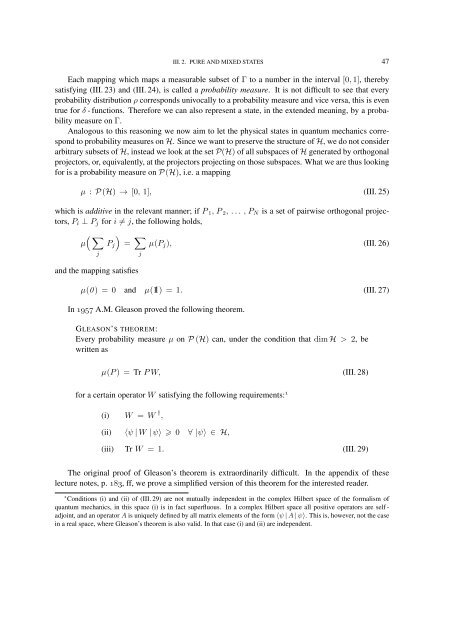FOUNDATIONS OF QUANTUM MECHANICS
FOUNDATIONS OF QUANTUM MECHANICS
FOUNDATIONS OF QUANTUM MECHANICS
You also want an ePaper? Increase the reach of your titles
YUMPU automatically turns print PDFs into web optimized ePapers that Google loves.
III. 2. PURE AND MIXED STATES 47<br />
Each mapping which maps a measurable subset of Γ to a number in the interval [0, 1], thereby<br />
satisfying (III. 23) and (III. 24), is called a probability measure. It is not difficult to see that every<br />
probability distribution ρ corresponds univocally to a probability measure and vice versa, this is even<br />
true for δ - functions. Therefore we can also represent a state, in the extended meaning, by a probability<br />
measure on Γ.<br />
Analogous to this reasoning we now aim to let the physical states in quantum mechanics correspond<br />
to probability measures on H. Since we want to preserve the structure of H, we do not consider<br />
arbitrary subsets of H, instead we look at the set P(H) of all subspaces of H generated by orthogonal<br />
projectors, or, equivalently, at the projectors projecting on those subspaces. What we are thus looking<br />
for is a probability measure on P (H), i.e. a mapping<br />
µ : P (H) → [0, 1], (III. 25)<br />
which is additive in the relevant manner; if P 1 , P 2 , . . . , P N is a set of pairwise orthogonal projectors,<br />
P i ⊥ P j for i ≠ j, the following holds,<br />
( ∑<br />
µ<br />
j<br />
P j<br />
)<br />
= ∑ j<br />
and the mapping satisfies<br />
µ(P j ), (III. 26)<br />
µ(0 ) = 0 and µ(11) = 1. (III. 27)<br />
In 1957 A.M. Gleason proved the following theorem.<br />
GLEASON’S THEOREM:<br />
Every probability measure µ on P (H) can, under the condition that dim H > 2, be<br />
written as<br />
µ(P ) = Tr P W, (III. 28)<br />
for a certain operator W satisfying the following requirements: 1<br />
(i) W = W † ,<br />
(ii) ⟨ψ | W | ψ⟩ 0 ∀ |ψ⟩ ∈ H,<br />
(iii) Tr W = 1. (III. 29)<br />
The original proof of Gleason’s theorem is extraordinarily difficult. In the appendix of these<br />
lecture notes, p. 183, ff, we prove a simplified version of this theorem for the interested reader.<br />
1 Conditions (i) and (ii) of (III. 29) are not mutually independent in the complex Hilbert space of the formalism of<br />
quantum mechanics, in this space (i) is in fact superfluous. In a complex Hilbert space all positive operators are self -<br />
adjoint, and an operator A is uniquely defined by all matrix elements of the form ⟨ψ | A | ψ⟩. This is, however, not the case<br />
in a real space, where Gleason’s theorem is also valid. In that case (i) and (ii) are independent.
















